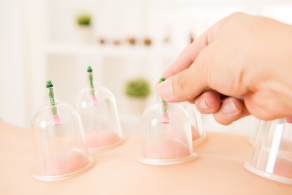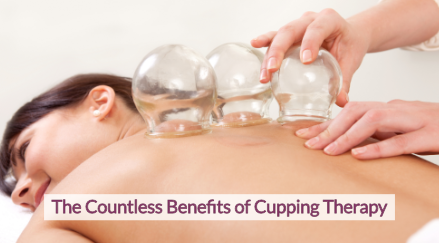Ancient therapy still leaves its mark today
It may look like something straight out of a science fiction film, but a time-honored technique known as cupping is becoming more and more popular among busy professionals. Used both as a way to relieve muscle pain and illnesses, as well as a form of stress relief, cupping is a style of alternative health care therapy that focuses on the movement of blood, energy, and body fluids using glass suction cups. The benefits of cupping are numerous and include relief of flu symptoms, congestion, and muscle stiffness.
Cupping falls within the realm of Oriental Medicine and is most often used in conjunction with Acupuncture and Moxibustion. Cupping dates to the Jin Dynasty (265-581), when the famous Taoist Ge Hong (281-341) described this method in his book, A Handbook of Prescriptions for Emergencies. The original cups used in this therapy were made from animal horns and used for draining abscesses. This type of cupping became known as Jiaofa, horn technique.
During the Tang Dynasty (618-907) China underwent many economic, cultural, and medical developments, and cupping was used to treat pulmonary disorders. During the Qing Dynasty (1644-1840) the Chinese began to use bamboo cylinders as cups. The treatments expanded to help with headaches, colds, body aches, joint pain and abdominal pain. Glass cups were created in the 20th Century. Since the glass cups are transparent, it is easier for the therapist to control the treatment. Cupping therapy continues to be used for arthritis, digestive disorders, muscle pain, respiratory conditions, infertility, and irregular menstruation.
Cupping, as a technique, now extends beyond its original goal of draining the body of abscess fluids, and people of many professions and backgrounds have discovered the benefits of regular treatments. Cupping gives people a sense of calmness during and after treatment, providing both the benefits of detoxification as well as massage. Cupping is based upon the Chinese Medical Theory, which believes that the body is invaded by external pathogens such as wind, cold and dampness. This essentially creates a pattern of ailments we know today as headaches, colds, body aches, joint pain, abdominal pain, and infertility.
Unlike many other types of treatments, the process of cupping is able to help dispel cold and release external pathogens. One idea behind the method of cupping is that the suction from the cup pulls the skin and fat away from the muscle creating a myofascial release. This allows blood to flow freely and improves circulation to an area that is congested. It is also effective for extracting toxins or pathogens from the open pores. Cupping has been found to work within the body up to four inches deep causing tissues to release toxins and activate the lymphatic system.

Cupping is a wonderful and therapeutic technique but remember that it can leave temporary marks on the skin for a couple of days. The process should not hurt, and it is advised that you do not use the technique over large blood vessels, ulcers, or over the abdomen on someone who is pregnant. If you are susceptible to bleeding or have a high fever you should also not try cupping. Usually, this therapy is done with acupuncture or other types of bodywork treatment done by a licensed acupuncturist, but some physical therapists have discovered this technique and have incorporated it into their practice. Each cupping session can last anywhere from ten to fifteen minutes and can be repeated until the problem is resolved.
Varied cupping techniques greatly enhance many acupuncture and bodywork therapies and intensify the therapeutic and detoxifying aspects of current treatments and we love using cupping to enhance our patient’s treatments and wellness routines at AIM Women’s Wellness Clinic. Since there’s virtually no risk to this treatment, expand outside the box next time you decide to do some bodywork and give cupping a try. The therapy is thoroughly relaxing and is wonderful alone or as the perfect end to any treatment.
Call us today +1 (805) 497-2625 to schedule an appointment.




